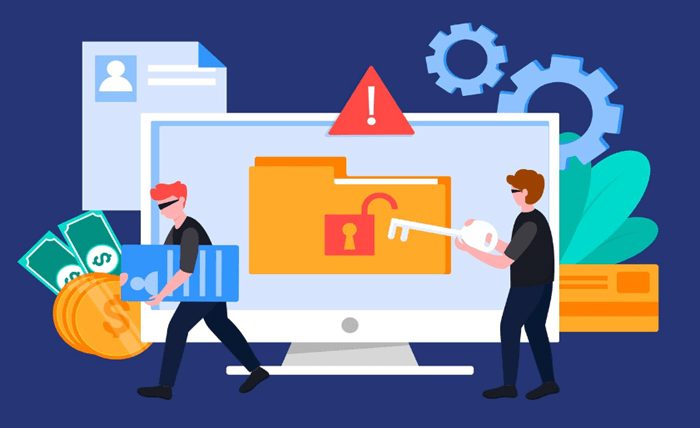Your organization ought to establish a cybersecurity awareness initiative to mitigate susceptibility to online scams. There exists a myriad of hazards, including phishing endeavors, DDoS assaults, ransomware incidents, social engineering ploys, and identity theft. In light of the recent ransomware breach targeting UnitedHealthcare, as documented by CNBC, it is evident that hackers perceive the healthcare sector, encompassing its workforce, nursing staff, medical practitioners, and patients, as susceptible prey.
Table of Contents
Phishing Attacks
Phishing attacks target individuals and organizations. Typically, fraudulent channels are used to lure people to provide sensitive information. The modus operandi, common even to many states like Florida, involves email phishing, pharming, spear phishing, and clone phishing.
Common Indicators of Phishing Emails: Phishing emails use incorrect or unfamiliar tones. Other indicators include a sense of urgency, suspicious attachments, and inconsistencies in links.
How to Identify and Avoid Phishing Scams: Criminals often send emails with suspicious links, telling you to click and open them. They might say it’s to sign up for something urgent. They’ll even ask for your credit card info, phone number, or authentication codes. This certainly appears to be a fraudulent scheme. The most effective measure to safeguard oneself against such deceptive tactics involves ensuring that your computer’s security software is regularly updated and implementing two-step verification for your online accounts.
About Malware Infections
Cybercriminals deploy intrusive malware to infect systems or steal data. The popular variants are worms, viruses, Trojan horses, adware, botnets, and rootkits.
Common Sources of Malware Infections: Cybercriminals often utilize phishing links, email attachments, portable media, and compromised websites as means to launch an attack.
Preventing and Detecting Malware: Ensure that your devices are consistently updated with patches, fortify your network security measures, deploy antivirus software, and activate firewall protection to safeguard your digital environment. Similar to the data breaches faced by many healthcare providers, all businesses in different industries also face the same data security hurdles. Proficient IT support in West Palm Beach focuses on key actions aimed at protecting and providing customized solutions to fulfill industry-related requirements.
Ransomware Attacks
Ransomware attacks use powerful algorithms to encrypt data, making your computer unusable or inaccessible.
Ransomware attacks use a payload where the victim clicks on a suspicious link that encrypts the files. Next, a ransom pop-up note is displayed on a computer screen. After you fulfill their demands, the hackers will unlock the decrypted files – no guarantees.
Notable Ransomware Incidents:
- TeslaCrypt – $500 per individual in 2015
- WannaCry – $4 billion loss in 2017
- SamSam – $6 billion loss in 2018
- NotPetya – $10 billion in 2017
Strategies to Use Against Ransomware:
- Software updates
- Network segmentation
- Limit user access privileges
- Installation of antivirus software
- Implement centralized patch management
Identity Theft
In the absence of a strong security system, criminals can obtain your credit card details and account numbers. They use pretexting and skimming strategies to lure you. To ensure you’re not a victim, you should:
- Monitor social accounts for suspicious activities
- Use strong passwords
- Safeguard personal information
- Stay informed about social security threats
Social Engineering Attacks
This type of cyberattack tricks the victim into making security mistakes. It uses various tactics to manipulate individuals to perform specific actions and divulge sensitive information.
Social Engineering Attacks:
In 2022, Microsoft warned that there was a spear phishing campaign between Russia and Ukraine. A group called ACTINIUM sent an email containing a tracking pixel that informed cybercriminals that it had been opened. Other examples include:
- Deepfake attack on UK Energy Company
- In 2021, a Microsoft phishing scam stole user credentials
- A phishing attack on Sacramento that exposed health information
- In 2020, high-profile Twitter accounts were compromised after a vishing scam
How to Guard Against Social Engineering Exploits:
- Verify the legitimacy of requests using trusted communication channels
- Use clear security policies to handle sensitive information
- Whenever possible, use multi-factor authentication
- Don’t share your personal information and report suspicious activities
Conclusion
Businesses across all industries must implement optimal strategies, systems, and protocols to mitigate cyberattacks effectively. It is paramount to exercise vigilance when confronting identity theft or phishing endeavors. Furthermore, empowering your personnel to address cyber threats and deploy preemptive security measures aligned with industry benchmarks is crucial.



